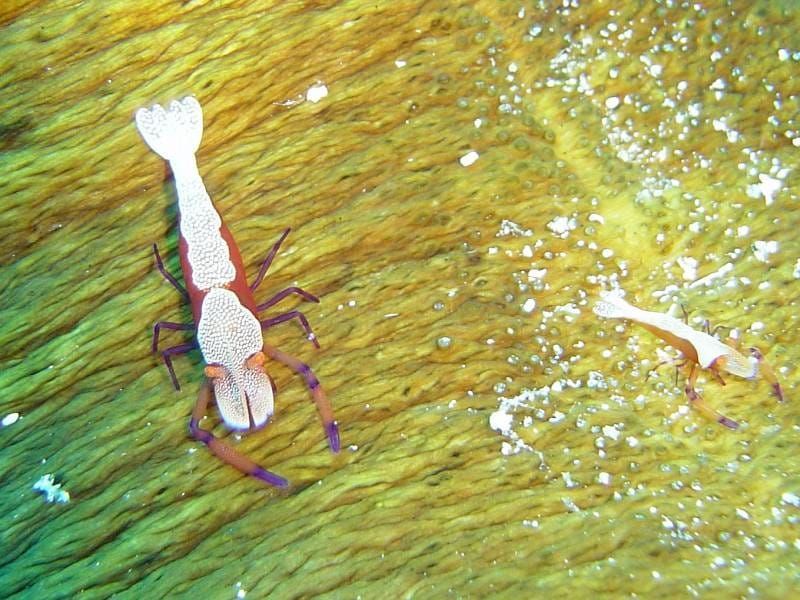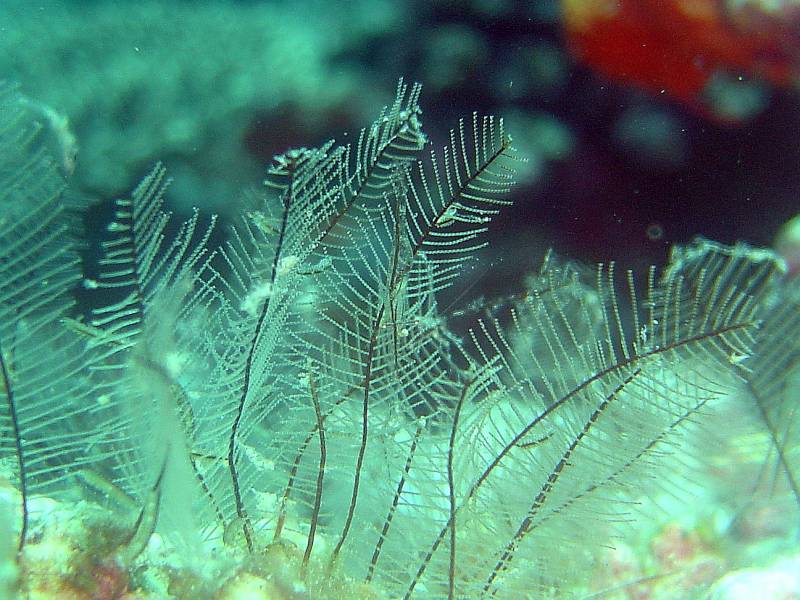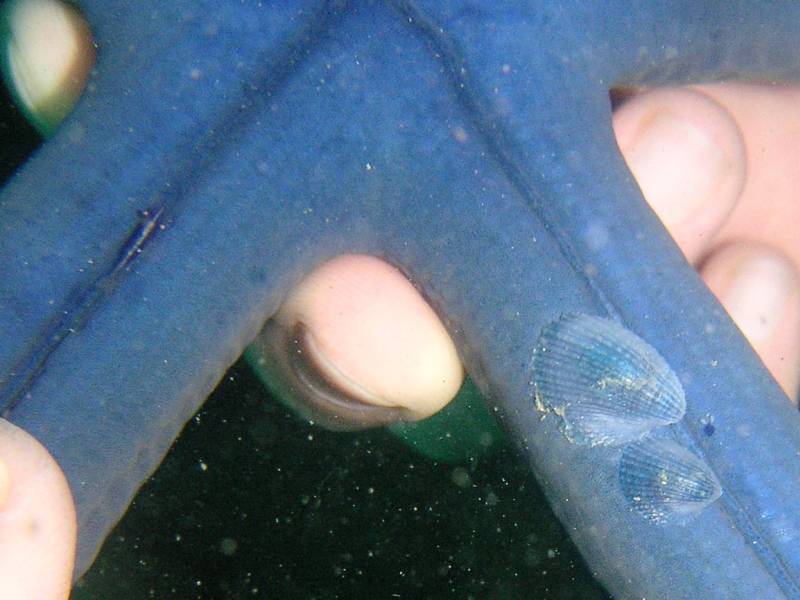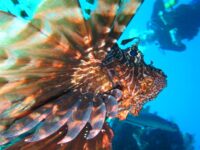When you think of shrimp, you likely think of the ones that end up on your plate, with only a few familiar species in mind. However, for divers, a whole new world unfolds beneath the water, revealing a fascinating variety of shrimp species, many of which are far from the ones you’re used to seeing.
Fiji’s coral reefs are home to a diverse array of shrimp species, contributing to the ecosystem’s complexity and vibrancy. These shrimp exhibit a variety of behaviors and symbiotic relationships with other marine organisms. For example, species like the emperor shrimp live on sea cucumbers, cleaning them of parasites, while others, such as the cleaner shrimp, engage in mutualistic relationships with fish by removing parasites from their scales. Other species like the pistol shrimp and mantis shrimp use specialized appendages for hunting and defense.
Many shrimp species are challenging to spot due to their color-matching with their host, their transparency, or their tendency to hide in the crevices of coral reefs for protection from predators.
Emperor shrimp

The Emperor shrimp (Zenopontonia rex) is commonly found living in symbiosis with sea cucumbers in Fiji’s coastal waters. This small, brightly colored shrimp, typically around 2.5 cm in length, attaches itself to the surface of the sea cucumber for protection. In return, the shrimp cleans the sea cucumber by feeding on its parasites and detritus. The relationship benefits both species, as the sea cucumber gains parasite removal, while the shrimp receives protection from predators. Emperor shrimp are often seen in a variety of hues, including orange and white, making them an interesting and vibrant part of Fiji’s marine ecosystem.
Durban dancing shrimp

The Durban dancing shrimp (Rhynchocinetes durbanensis) is a vibrant species of shrimp found in Fiji and the whole Indo-Pacific region. This species is notable for its striking red and white striped coloration, which serves as camouflage among the coral reefs and seagrass beds it inhabits. Known for its unique and fascinating “dance,” the Durban dancing shrimp performs intricate, rhythmic movements, often waving its front legs in an almost choreographed fashion. These movements are believed to be part of courtship rituals or a way to communicate with other shrimp.
The shrimp grows to about 5 cm in length and primarily feeds on detritus, small invertebrates, and algae. Though not considered a commercial species, its stunning appearance and behavior make it a popular choice for aquarium enthusiasts. Despite its beauty, it is important for these shrimps to be preserved within their natural reef environments.
Banded coral shrimp

The Banded coral shrimp (Stenopus hispidus) is a common species found in tropical and subtropical waters across the Indo-Pacific region, from the Red Sea to Hawaii and Japan. It is easily recognizable due to its bold, banded red and white coloration that gives it its name. Typically, these shrimps inhabit coral reefs, rocky outcrops, and crevices where they can hide from predators while foraging for food. They are often seen cleaning larger fish, including groupers and moray eels, by removing parasites, dead skin, and other debris from their scales and gills—a behavior known as cleaning symbiosis. This mutualistic relationship benefits both the shrimp, which gains food, and the fish, which enjoys better health.
Banded coral shrimps grow up to 6 cm in length and possess long, slender antennae that they wave in an intricate manner, which may serve to ward off threats or signal to potential mates. While they are not aggressive toward humans, they can become defensive when threatened, using their sharp claws to fend off intruders. These shrimps are nocturnal, remaining hidden during the day and emerging at night to feed and clean. Their vivid appearance and fascinating behaviors make them popular in both marine aquariums and among divers.
Peacock-tail anemone shrimp

The peacock-tail anemone shrimp (Ancylocaris brevicarpalis), is a small, symbiotic shrimp belonging to the family Palaemonidae. Adults typically reach a body length between 1.5 and 4 cm.
The shrimp has a graceful, transparent body adorned with characteristic white spots and often orange spots with black rings on its tail fan. Purplish-blue rings may also appear near the joints of its claw arms. 
This species is found in Fiji and throughout the Indo-Pacific region. Like other anemone shrimp, it cannot survive without the protection of a sea anemone.
To avoid being harmed by the anemone, the shrimp produces a protein that mimics the anemone’s own tissue, tricking the anemone into recognizing it as part of itself, similar to the relationship between clownfish and anemones.
Ancylocaris brevicarpalis is considered a scavenger and detritivore, feeding on small particles of organic matter.
Bubble Coral Shrimp

The Bubble Coral Shrimp (Palaemonella colemani) is a small ,beautiful, filigree-built, semi-transparent shrimp that lives in symbiosis with the bubble coral, hence the name.
It has a translucent, almost colorless body with long, slender legs, and its small size—usually reaching a length of about 2-3 cm—allows it to easily hide within the bubbles of the coral, providing it with both shelter and protection.
The bubble coral shrimp feeds on plankton, detritus, and tiny invertebrates that swim by and filter food particles from the water. It hides among the coral’s bubbles and, in turn, helps clean the coral by removing debris and parasites, thus forming a mutualistic relationship with the coral. Unlike many other shrimp species, Palaemonella colemani is generally shy and prefers to remain hidden within the bubble-like structures of its host coral, emerging only at night to forage.
Though not widely studied, the Bubble Coral Shrimp’s relationship with bubble corals and its fascinating behavior make it an interesting species for marine enthusiasts. Its delicate role in maintaining the health of coral ecosystems underscores the importance of preserving coral reefs and their intricate web of life.
Ambon Cleaner Shrimp

The Ambon Cleaner Shrimp (Lysmata amboinensis) is a vibrant and active species in Fijis corall reefs. This shrimp is easily recognized by its striking red and white banding, which runs across its body and legs. Typically, Lysmata reaches a length of about 3 to 4 cm, its social , often gathering in groups and living in crevices or caves within coral reefs.
This species is known for its important ecological role as a cleaner shrimp. It forms mutualistic relationships with larger fish, particularly in coral reef ecosystems. The shrimp feeds on parasites, dead tissue, and other debris found on the skin and gills of its host fish. In exchange, the fish receive a cleaning service, benefiting from the removal of harmful organisms. Lysmata grabhami is often seen “cleaning” larger fish such as groupers, parrotfish, and moray eels, and its actions are a key part of maintaining the health of reef ecosystems.
| The Ambon Cleaner Shrimp (Lysmata amboinensis) is probably one of the most diligent cleaner shrimps a diver can encounter. All you have to do is carefully approach the shrimp with your hand, and the cleaning begins.
If you are brave enough, get your face close to the shrimp, remove your regulator for a moment, and open your mouth wide; the shrimp will enter your mouth and will pick your teeth clean. To get the busy cleaner out again, you only have to make a slight closing movement, and the shrimp is out. (Only for the experienced divers!!!) |
Feather star shrimp

Feather star shrimp ( Hippolyte catagrapha), are small crustaceans in the order Decapoda, related to crabs and lobsters. They are typically classified under the infraorder Caridea, also known as true shrimp, and often belong to the Hippolytidae family. These shrimp form a commensal relationship with feather stars, a type of crinoid. They have adapted to their host with camouflage that helps them avoid predators and blend in with their surroundings.
Their diet consists mainly of detritus, algae, and small parasites found on the feather star. Anatomically, they have the typical decapod structure with ten legs and swimmerets for movement and respiration. Their first pair of legs has small claws for feeding. The shrimp’s colorful patterns come from pigments in their exoskeleton, which can change slightly between molts. They go through larval stages before settling on a feather star host, with ongoing research refining their phylogenetic relationships.
Crinoid Shrimp

Periclimenes crinoidalis, also commonly known as the Crinoid Shrimp, is a small and fascinating species of shrimp inhabiting the arms of crinoids, or sea lilies. This shrimp is renowned for its transparent body, which provides excellent camouflage, allowing it to blend seamlessly with its host, the crinoid. Typically measuring about 2 cm in length, P. crinoidalis exhibits a symbiotic relationship with crinoids, where it seeks refuge among their arms for protection from predators while feeding on plankton, small invertebrates, and detritus that accumulate around the crinoid.
In return, the crinoids benefit from the shrimp’s cleaning activities, as it helps remove parasites and debris from their surfaces. This mutualistic relationship is vital for both species. Periclimenes crinoidalis is typically found in shallow, coral reef environments, where its small size and transparent appearance make it an elusive species to spot. It’s fascinating relationship with crinoids highlights the complexity and interconnectedness of reef ecosystems.
Green-eye Dancing Shrimp

The Green-eye Dancing Shrimp (Cinetorhynchus reticulatus) is a small species renowned for its distinctive green eyes and remarkable behavior. Typically measuring around 2 to 3 cm in length, it has a translucent body with fine, reticulated markings, giving it a striking appearance. The shrimp is often seen performing an elegant “dancing” motion, a behavior that is part of its communication or mating rituals.
It commonly resides in the crevices of coral reefs or among the branches of soft corals, where it can easily blend in with its environment. The Green-eye Dancing Shrimp feeds on plankton and small organic matter that it collects from the water. While its transparent body and vibrant green eyes make it visually captivating, the shrimp is also known for its shy, elusive nature. The species plays a role in maintaining the health of reef ecosystems by cleaning and scavenging.
Translucent Gorgonian shrimp

The Translucent Gorgonian shrimp (Manipontonia psamat) is a small shrimp species found primarily on gorgonian corals. Known for its translucent body and delicate appearance, this shrimp typically measures around 1.5 to 2 cm in length. Its transparent form allows it to blend seamlessly with its environment, offering protection from predators as it resides among the intricate branches of gorgonian corals. This shrimp’s elusiveness, combined with its small size, makes it a challenging species to observe.
The shrimp forms a mutualistic relationship with the gorgonian corals, where it benefits from the shelter provided by the coral’s structure. In return, Manipontonia psamathe helps keep the coral clean by feeding on detritus, plankton, and small organisms that may accumulate on the coral. This symbiotic interaction contributes to the health of both the coral and the shrimp, as the shrimp has access to food while the coral remains free of debris.

Not entirely sure about the identification of this species. It could be a species of Hamodactylus. They also live on gorgonians but have shorter arms compared to the species Manipontonia psamathe.
Their small size, combined with the gorgonian corals’ complex branching structure, makes them generally hard to spot due to their transparency and camouflage within the coral branches.
Hydroid Shrimp

Rapipontonia galene, commonly known as the Hydroid Shrimp, lives on hydroids, a group of colonial marine invertebrates that secrete a stinging toxin and are best left untouched. Typically, Rapipontonia galene is found living on the branches or within the colonies of hydroids, where it relies on the structure for both shelter and food.
The shrimp itself is relatively small, usually measuring around 2 to 3 cm in length, and is characterized by its translucent body, which helps it blend in with its environment. This camouflage offers protection from predators while it remains safely hidden among the hydroids. The shrimp feeds primarily on small planktonic organisms, organic detritus, and sometimes even the hydroids’ polyps, though its impact on hydroid colonies is minimal.
Rapipontonia galene is known for its remarkable symbiotic relationship with its host hydroids, as it assists in cleaning the hydroids from debris. This mutualistic interaction benefits both species, as the shrimp gains food and protection, while the hydroids enjoy reduced clogging from organic matter. This species is typically found in the shallow, clear waters of coral reefs, where it contributes to the delicate balance of the ecosystem. Its elusive nature and transparent appearance make it a challenging, yet rewarding, species to observe.
Seastar shrimp

The Blue Sea Star (Linckia laevigata) is very common in the shallow coastal waters of Fiji’s beaches, and is photographed and viewed by dozens of beachgoers and snorklers every day. A closer look reveals something fascinating: tiny shrimp, sometimes several, living on the underside of the starfish.
The Seastar shrimp (Zenopontonia soror) forms a unique symbiotic relationship with sea stars. The shrimp is typically found living on the surface of its host sea star, where it takes shelter and protection. In return, the shrimp assists in cleaning the sea star by removing parasites, detritus, and other debris from its body.
Zenopontonia soror adapts its color to its symbiont so it has effective camouflage. Typically reaching a length of about 2 cm, the shrimp is highly adapted to life on the sea star, using its long, slender legs to cling to the host.
In the picture above, you can also see two barnacles attached to the starfish. And next to the barnacles, you can also see a tiny copepod (Cyclopoid Copepods). These tiny crabs also live parasitically on echinoderms.
Fiji’s waters are home to a rich diversity of marine life, including a wide variety of beautiful shrimp species. While the exact number of shrimp species is not fully known, more than 100 species have been documented in the region so far. This number continues to grow as previously unknown species are regularly discovered.
Overall, Fiji’s shrimp fauna is highly diverse, making the region a key area of interest for marine research. It is also a hotspot for both scientific study and ecotourism, attracting researchers and nature enthusiasts alike.


